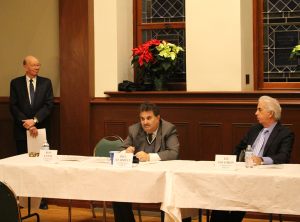
Deliberations at Advisory Neighborhood Commission meetings will determine the future of the 2018 Campus Plan.
The next Georgetown University Student Association executive, who will be elected next week, will play an important role in the upcoming negotiations for the 2018 Campus Plan.
The university and the neighboring community will negotiate to solidify plans for the next 20 years of construction and maintenance around campus as part of the 2018 Campus Plan. Contentious negotiations for the 2010 Campus Plan required the university to house more students on campus, necessitating extensive construction projects around campus.
According to Associate Vice President for Community Engagement and Strategic Initiatives Lauralyn Lee, who heads the Office of Community Engagement, the negotiation process has already commenced, and the incoming GUSA leadership will take up an important role in the process.
“What we have been doing through [Georgetown Community Partnership] in the past two-and-a-half years is developing and working through the elements of the substance of what will compose of the plan,” Lee said. “We have lots of forums for student meetings in residence halls around specific projects, an open forum every semester, as well as GUSA-led working group focused on planning issues. All these activities [are] an effort to involve GUSA leadership and other students in the planning process.”
The GUSA executive has taken up a central role in Georgetown Community Partnership, the forum created as part of Georgetown University’s 2010 Campus Plan, to facilitate discussion, information sharing and consensus-based decision-making on issues of shared concern to the university and the neighborhood.
The GCP is led by a steering committee made up of university leaders, neighborhood civic leadership and the GUSA President.
Current GUSA President Trevor Tezel (SFS ’15) said that the future executive leadership must have a strong grasp of student needs to advocate effectively on behalf of the student body during the negotiation.
“It’s going to take a strong executive that’s prepared to state and articulate student principles that are non-negotiable, but still at the same time be willing to come to the table so that we can get an agreement that can be hammered out in unison with the principal that the university and the neighborhood want to advance as well,” Tezel said.
Advisory Neighborhood Commissioner Reed Howard (SFS ’17) noted that since the GUSA president is the only student representative on the GCP steering committee and the master planning subcommittee, the winner of the Feb. 19 election would thus play an integral role in the future negotiations.
“The campus plan will affect the next 20 years of student life on the Hilltop, and we need an executive team with extensive knowledge and relationships in this area so that they can immediately hit the ground running as effective representatives,” Howard wrote in an email. “Right now the advocacy effort on behalf of the student body is fragmented and in need of greater coordination. The GUSA executive is uniquely positioned to mobilize the student body in a single direction.”
Promoting student representation in neighborhood organizations to increase the student voice in community affairs has been a focus for GUSA executives in the past few years, including Tezel and GUSA Vice President Omika Jikaria (SFS ‘15). Because of the sole student voice on the steering committee, six working groups were created under the steering committee to involve a greater level of student representation, which GUSA has helped to provide.
GUSA Undersecretary for Neighborhood Relations Olivia Hinerfeld (SFS ’17) noted that over the past year, the executive had primarily worked with increasing student representation in the GCP working groups and on the Advisory Neighborhood Commission. Two of the eight single-member districts of ANC2E, the region that includes Georgetown, feature student representatives: Howard and Kendyl Clausen (SFS ’16).
“I think that’s certainly the most important issue for students, particularly with the 2018 Campus Plan — ensuring that we have students involved at every point in the process,” Hinerfeld said.
Despite the variety of students working on the campus plan issue, GUSA senate Speaker Tyler Bridge (COL ’17) pointed to a lack of coordination between the executive and the senate as an area for improvement under the next administration in anticipation of future negotiations.
“Basically, what we have right now is a system of GUSA meeting once a week or twice a week with upper-echelon administrators in certain boards and certain meetings, and the president is supposed to convey that to the cabinet and somehow supposed to trickle down into the senate,” Bridge said. “I do not think that’s how we should work at all.”
Beyond the neighborhood, the GUSA president and vice president also represent the student body in wider city affairs, according to Tezel.
“Just a couple of weeks ago we were at a town summit to discuss some of the issues that Mayor [Muriel] Bowser was going to be facing as she took over. And we were able to provide feedback along with other D.C. committee members,” Tezel said.
Lee similarly highlighted Tezel and Jikaria’s work with voter registration.
“GUSA leadership has been involved in student voting — registering to vote in the District — so that we have the power of their voice as a District resident, in both city and local policy and federal policy,” Lee said.
With the increasing importance of neighborhood relations, the next president and vice president will likely continue the trend of occupying a neighborhood relations cabinet position that will work with the Office of Community Engagement to coordinate community events.
“Both the past and current GUSA had cabinet positions that were focused on neighborhood relations and D.C. relations. People in these roles have helped to recruit students for neighborhood events that our neighborhood association put on like picnic in the summer, community days or concerts,” Assistant Director of Community Engagement Jamie Scott said. “We think it’s important that students are participating in community life and to get students involved in neighborhood activities.”




















